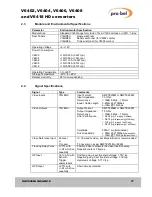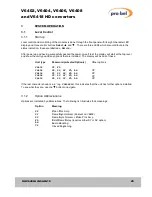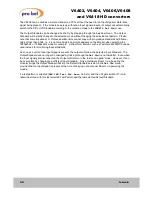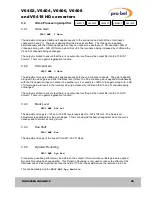
V6402, V6404, V6406, V6408
and V6418 HD converters
HU-V6402&4&6&8&18
31
3.2.13
Video Reference Mismatch
When a mismatch between the Video Input's (Vid I/P) frame-rate and the Reference's frame-rate is being
detected, the output can either follow the Vid I/P or the Reference, depending on the setting of
VIDEO
:
XStdMode
(also known as 'Cross-Reference' mode).
Available options are:
XStd Ref
:
Output frame-rate is set to Reference frame-rate, no matter what the Video Input
frame-rate is.
XStd I/P
:
Output frame-rate is set to Video Input frame-rate
V6402 Example:
Vid I/P is 720p @ 59.94Hz
XStdMode is set to
XStd Ref
Ext. Reference changes from 59.94Hz to 50Hz
ð
Output frame-rate instantly changes to the Reference frame-rate, i.e. the Output standard will be 720p
@ 50Hz thereafter. The Output picture will look somehow corrupted - which is absolutely normal - but the
Output video timing fully complies with the 720p50 standard. The reader should be reminded here that no
member of the V64xx Series can perform frame-rate conversions (e.g. 59.94Hz to 50Hz).
The Frame Synchronizer will automatically resume normal operation as soon as a frame-rate match has
been re-established.
3.2.14
Delay Signal
The Frame Synchroniser produces a signal that represents the variable delay being inserted into the video
path. This delay information is passed on internally to the V6302 Advanced Audio Processor (if present)
and used to provide a tracking delay to the audio. The signal is also available externally so it can be used
by other audio tracking devices. Please note that the length of the tracking delay pulse is a measure for
the variable delay between input and output only – it does not cover for any additional Field/Frame-Delay
added on top of the variable delay.
The Delay signal has repetition rate of two frames and the positive pulse width represents the variable
delay. This is shown in this diagram.
2 Frames
Delay
If the unit is not synchronising, such as loss of I/P or Freeze, then the delay output is blanked (static low).
It is expected under these conditions that the audio processing will hold its current delay from the last valid
measurement until a pulse re-appears.
The external Delay Pulse output is available on a BNC on the rear panel. The external pulse itself is
nominally 3.3V with a sourcing/sinking capability of
±
24mA.
















































